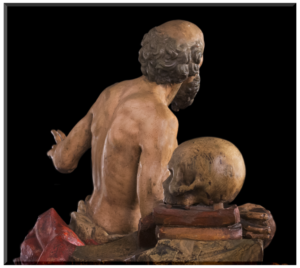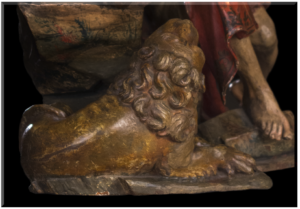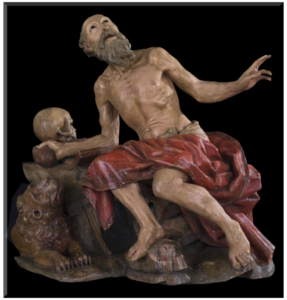Object of the Month: January 2020
St. Jerome
Polychrome and giltwood
Unknown Spanish
17th century
The obsessive attention to realistic detail and heightened emotion that characterized many 17th-century paintings is also evident in this dramatic polychrome sculpture. The adjective polychrome (meaning “many colored”) refers to the color on the wood which enhances the figure’s lifelikeness. Although this technique can be traced back to the Greeks and Romans, it became particularly popular during the Renaissance. Spanish sculptors who preferred wood to stone became especially adept at using the technique, often adding “gilding and brilliantly imaginative lusters.”
Jerome, the subject of this work, was born in the fourth century in the small town of Stridon (located in the Balkans today). Initially schooled by his father, he later traveled to Rome where he became proficient in Latin and Greek and excelled in oratory. His later biographical writings lament that this early success encouraged in him an overweening pride and ambition. He continued his education in Trier, a German city on the banks of the Moselle river. It was here that his Christian conscience was reawakened, and as one source notes, “his heart was entirely converted to God.” However, by his own admission his competitive nature and “rambling imagination” continued to trouble him throughout life. He lived in the desert of Chalcis for several years but eventually returned to Rome in 382 to become special secretary to Pope Damasus I. It was Damasus who assigned him the task of creating a revised Latin version of the Bible. The Vulgate, as it is known, was completed in 405. Jerome eventually retired to a monastery in Bethlehem where he died in 420.
 As is typical of the era the creator of this work uses numerous attributes to identify the figure and to illustrate his story. For example, the books stacked on the rock and supporting the aged Jerome represent his writings (most notably the Vulgate but also his other letters and theological treatises). The skull resting atop two of the books signifies the transience of life or natural death; notice however, that Jerome is turning away from “death” to gaze heavenward–the source of new, eternal life. The brilliant red cloak “embroidered” with fleur de lis seems rather out of place in the wilderness setting. However, in this context it represents Jerome’s office as a cardinal. Although, the position of cardinal did not exist in the early centuries of the church, ecclesiastics of Rome, like Jerome, held the duties that later fell to cardinals.
As is typical of the era the creator of this work uses numerous attributes to identify the figure and to illustrate his story. For example, the books stacked on the rock and supporting the aged Jerome represent his writings (most notably the Vulgate but also his other letters and theological treatises). The skull resting atop two of the books signifies the transience of life or natural death; notice however, that Jerome is turning away from “death” to gaze heavenward–the source of new, eternal life. The brilliant red cloak “embroidered” with fleur de lis seems rather out of place in the wilderness setting. However, in this context it represents Jerome’s office as a cardinal. Although, the position of cardinal did not exist in the early centuries of the church, ecclesiastics of Rome, like Jerome, held the duties that later fell to cardinals.
 One other imaginative story connected to Jerome and recorded in The Golden Legend occurs during his retirement in Bethlehem. According to this story, as the monks were going about their daily routine, a wounded lion suddenly appeared. All fled but Jerome. Examining the beast, he discovered and removed a thorn that was deeply embedded in its paw. In gratitude the lion became Jerome’s constant companion and protector of the monastery. This beautifully carved attribute “rounds out” the base of the sculpture.
One other imaginative story connected to Jerome and recorded in The Golden Legend occurs during his retirement in Bethlehem. According to this story, as the monks were going about their daily routine, a wounded lion suddenly appeared. All fled but Jerome. Examining the beast, he discovered and removed a thorn that was deeply embedded in its paw. In gratitude the lion became Jerome’s constant companion and protector of the monastery. This beautifully carved attribute “rounds out” the base of the sculpture.
Donnalynn Hess, M&G Director of Education
Published in 2020
